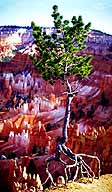Bryce Canyon

Bryce Canyon is carved out of the edge of the Paunsaugunt Plateau. Bryce is not a true Canyon, it is an ampitheater. Horseshoe or Bowl shaped erosions are considered to be ampitheaters. Bryce is quite high up at 7500 feet and higher. Because of the altitude, even though the day-time temperatures are quite pleasant, the night-time temperatures drop to the 20's or the teens.

The vertical rock spires are called "hoodoos." They are carved by the repeated action of freezing and thawing in combination with all the other forces of erosion. The night-time temperture at Bryce drops below freezing an average of 200 times per year! You can see other examples of hoodoo's in Kodachrome Basin, just outside Bryce. The beautiful colors of these formations are due to iron (reds, yellows, and browns) and manganese compounds.(purples) The colors change with the time of day and weather conditions. Dawn and Sunset are the best times to photograph Bryce. If you are lucky enough to be in Bryce while it has a cloud cover, take a look at the Canyon in the evening, as the sun peaks underneath the clouds. The refraction of the light off the clouds makes the Canyon litterally glow with irradesant colors. It is a marvel to behold!

Bryce Canyon was named after Ebenezer Bryce, a cattle rancher. He is quoted as saying that the canyon would be, "...a hell of a place to lose a cow."

To view more great images of Bryce Canyon, Click on these Links. They each take about 1 minute to load, if you have a 28.8 modem. All are well worth the wait.
Bryce Hoodoo's
Pretty Bryce
Bryce Canyon Tree
Visitors can enjoy Bryce Canyon during any season. Summer days are pleasant and the nights are cool. Much of the area's precipitation comes as afternoon thundershowers during mid to late summer. Spring and fall weather is highly variable.
Cold winter days are offset by high altitude sun and dry climate. Winter nights are sub-freezing. During some winters, Alaskan cold fronts descend on the Colorado Plateau bringing temperatures as low as 30 degrees below zero. The area can have snowstorms from October through April; annual snowfall averages 100 inches.

Bryce Canyon National Park
P.O. Box 170001
Bryce Canyon, Utah 84717-0001
TELEPHONE:
(435) 834-5322
The park has two campgrounds, North and Sunset, with 218 sites available on a first-come, first-served basis.
Sign My Guestbook
View My Guestbook
![]()
LE FastCounter



